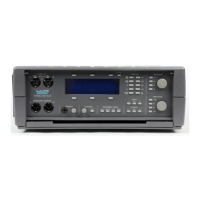.
WTD – The ‘weighted’ selection allows selection of a variety of
weighting filters with a selectable lower band limit. The lower
center soft key selects the lower band limit (<10 Hz or 400 Hz).
The lower right soft key selects among the following weighting
filters:
.
IEC-A – A-weighting filter per IEC 179, true RMS detector
.
CCIR-1k – Weighting per CCIR-468, true RMS detector
.
CCIR-2k – Weighting per CCIR-468, but with 0 dB gain
point at 2 kHz rather that 1 kHz, true RMS detector
.
CCIR-QPK – Weighting per CCIR-468, quasi-peak detector
.
CCIR-ARM – Weighting filter shape per CCIR-468, but
with 0 dB gain point at 2 kHz rather that 1 kHz,
average-responding detector per Dolby Bulletin 19/4
.
AUX1 – Weighted with optional weighting filter installed in
slot 1. If there is no filter in slot 1, the display will read ‘NO
AUX1’ and no filter is selected.
.
AUX2 – Weighted with optional weighting filter installed in
slot 2. If there is no filter in slot 2, the display will read ‘NO
AUX2’ and no filter is selected.
Selection of the proper band-limiting filters is of critical importance in
THD+N measurements. The dominant signal is often wideband noise
when measuring high-quality audio devices, so the specified
band-limiting filter must be used if measurements are to correspond to
manufacturer’s specifications. The 80 kHz lowpass filter is the most
commonly used, since it eliminates wideband noise while passing the
2nd and 3rd harmonics of frequencies within the audio band.
THD+N measurements are normally made at amplitudes near
maximum for the device-under-test. This is generally the worst-case
amplitude for distortion, and it minimizes the effect of noise, which is
generally independent of the signal amplitude. If the fundamental tone
is at a low amplitude, the noise will be greater amplitude relative to the
overall amplitude, so the THD+N reading will be higher.
In addition, the voltmeter used to measure the signal before filtering
has limited dynamic range, so accuracy suffers when measuring signals
with a fundamental tone below about 10 mV.
& The shapes of the
weighting filters are
shown in Appendix E.
& For more
information on
selection of
band-limiting filters,
see the special section
on Selecting
Bandwidth, page 4-31.
4 Operation
Operation Controlling the Analyzer : THD+N (Total Harmonic Distortion plus Noise)
4-28 Portable One Plus Access User's Manual
Artisan Technology Group - Quality Instrumentation ... Guaranteed | (888) 88-SOURCE | www.artisantg.com

